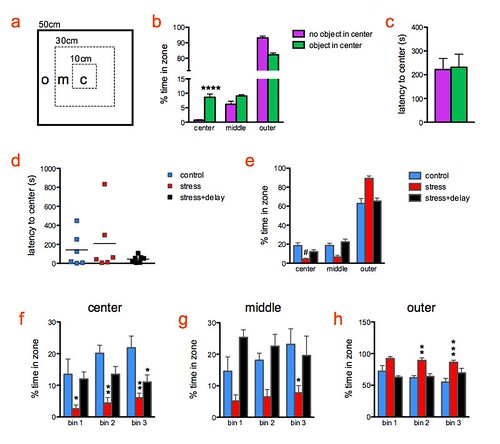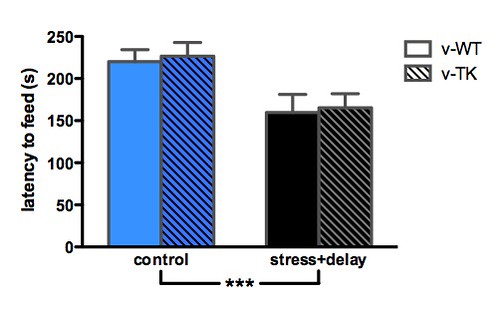The following data can be cited using this permanent identifier: hdl.handle.net/10779/7d8f2506fc029d16eeffd1350c42980a. You can also find a PDF of the complete data and text there.
The purpose of these experiments was to determine the immediate and delayed effects of stress on anxiety/depressive behavior. For the open field and elevated plus maze experiments male CD1 mice (Charles River) were used (n=6-8 per group; arrived at 7 weeks of age, tested at 9-11 weeks, handled for 5 days prior to testing). The GFAP-tk mice used for the novelty-suppressed feeding test were as described in Snyder, 2011, Nature. Mice were housed 4/cage, kept on a 12 hour light/dark cycle with lights on at 6 am and were tested during the light phase. Testing was performed either directly from the home cage (controls), immediately following 30 min restraint (stress) or following 30 min restraint with a 30 min post-restraint delay interval (stress+delay).

Figure 1: Increased fear/anxiety in the open field immediately following stress. a) The open field was a white plastic box (50cm x 50cm x 50cm) which was divided into outer (o), middle (m), and center (c) regions. Mice were tracked with Ethovision software (Noldus) and latency to approach the center region and time spent in the 3 regions during a 15 min test was calculated. Light intensity was approxmiately 150 lux. b) The presence of an object (~2 cm diameter, 3 cm tall wire metal cylinder containing a marble) in the center of the open field increased time spent in this subregion, and was therefore included in subsequent experiments (i.e. d-h; ****t-test P<0.001 vs. no object). c) The presence of the object did not affect the latency to approach the center of the open field. d) Neither stress condition affected the latency to approach the center of the open field. e) Stress significantly reduced the time spent in the center of the open field but this effect was absent after 30 min (stress+delay group; 1 way ANOVA main effect P=0.001, #Tukey post-test P<0.001 vs. control & P<0.05 vs. stress+delay). f-h) Time spent in the center, middle and outer regions across the test’s 3 x 5 min bins. Compared to controls, stress reduced time spent in the center and middle regions and increased time spent in the outer region (2 way repeated measures ANOVA, main effects of treatment all P<0.01, effect of time and interactions ns; Bonferroni post-test *P<0.05, **P<0.01, ***P<0.001 vs. control).

Figure 2: Reduced anxiety in the elevated plus maze 30 min after stress. Mice were subjected to a 5 min test in the elevated plus maze under bright (~150 lux; a-g) and dark (15 lux; h-n) conditions. The elevated plus maze had two open arms and two opaque closed arms and was located in the center of the testing room. a) Stress+delay increased the amount of time spent in the open arm during the first 2.5 min of the test (bin 1; *t-test, P<0.05). b) There was no difference between groups during the 2nd bin. c) For the entire test, there was a trend for stress+delay mice to spend more time in the open arms (†t-test, P=0.09). d) Stress+delay mice specifically spent more time in the inner third of the open arms (repeated measures ANOVA, effect of stress+delay P<0.05, open arm subregion P<0.0001, interaction P<0.001, ***Bonferroni post test P<0.001 vs. control). e) Stress did not alter distance travelled. f) Stress did not alter the number of stretch-attend postures (scored every 5 sec from video stills). g) Stress increased the number of head dips during the 5 min test (scored every 5 sec from video stills; t-test, P<0.001). h-n) In all of the same measures, stress+delay did not alter behavior relative to controls when the elevated plus maze was performed under dark conditions. Distance travelled was greater in the dark condition (2 way ANOVA effect of lighting P<0.001).

Figure 3: Reduced anxiety/depressive behavior in the novelty-suppressed feeding paradigm 30 min after stress. Mice were food deprived for the novelty-suppressed feeding test, which was performed in the same boxes as the open field tests, but with bedding covering the floor and a food pellet in the center, placed on a platform (protocol identical to Snyder, 2011, Nature but with a 30 min delay between restraint and testing). Stress+delay reduced the latency to begin feeding, equally in v-WT and neurogenesis-deficient v-TK mice (2 way ANOVA, effect of stress+delay P<0.001, effect of genotype P=0.7, interaction P=0.9).
In sum, stress can increase anxiety immediately after termination of the stressor: stressed mice spent less time than controls in the center of the open field. Stress can also reduce anxiety at later times after termination of the stressor: stress+delay mice spent more time in the open arms of the elevated plus maze, stress+delay mice displayed more head dipping behavior in the elevated plus maze, and stress+delay mice ate sooner in the novelty-suppressed feeding test. Also, in the open field, 1/3 of mice in the control and stress groups did not approach the center until 4+ min had elapsed. In contrast, though not significantly different, there was less variability in the stress+delay mice with all approaching the center by ~2 min, consistent with the possibility that stress+delay is reducing anxiety in some of these mice.
Is there any data on vigilance vs arousal at these time points after stress?
Good question. I haven’t scoured the literature but my feeling is that these things haven’t been systematically examined the way they should, or the way you’d think they’d be.
Is it that stress can decrease anxiety or increase the fight/flight response? Stress may make an animal more likely to take risks (i.e. spend more time on open arms) in order to ensure its survival under adverse circumstances. Stress may also cause the latency to feeding time to drop relative to controls since it’s looking to consume as many resources as it can a) because its expending a lot of energy due to the mobilization of resources via the sympathetic nervous system in response to the stressor and b) because it is looking to stock up in the case that further danger lies ahead.
This is a great point Heather. I didn’t discuss the data but indeed wanted to share it because I think there’s a broad assumption that stress is always “bad”, and more likely to lead to anxious or depressed behaviors. Thinking about stress in the context of survival, your point certainly makes sense. What you’re describing fits with work by the Blanchards and Gray & Mcnaughton, suggesting that as the perceived distance of the threat changes, so does behavior. At early timepoints after stress it may be most advantageous for animals to be “anxious”, i.e. avoid threatening situations. But soon after, when it’s clear there’s a degree of safety, maybe behavior changes so as to take advantage of opportunity for escape, eating etc.